Introduction
SEO was never meant to be easy, but it was a system we all understood. The moment AI content came into the scene, there was excitement. Because AI tools like ChatGPT promised faster content creation, limitless scalability. But as AI content flooded the internet, traffic started to drop. Rankings began to fluctuate. Search engines were caught off guard.
Soon after, the questions started. “Does AI content hurt search rankings?” Search engines, skeptical at first, began adjusting their algorithms, unsure how to handle AI-generated content flooding the web.
Fast forward a few months, and the SEO norms had completely shifted. SEO wasn’t what it used to be. Search engines were evolving. Users were now getting answers instantly on the search results page, bypassing the need to even click through to a website. Zero-click searches had arrived.
Now, marketers are left wondering, again: “Will AI content kill traditional SEO?” While some feared the worst, others embraced the change. Brands started seeing AI as an opportunity, using AI-generated content and large language models (LLMs) to direct traffic to their websites and enhance user experience.
In today’s blog, we’ll dive into how AI is reshaping SEO, how search engines are evolving, and how you can leverage AI content to boost your SEO strategy. Let’s break it down.
How AI is Disrupting SEO Norms?
AI is reshaping how SEO works, from what users search for, to where they search, and how search engines serve results. SEO is evolving into GEO (Generative Engine Optimization) and AEO (Answer Engine Optimization). As users turn to tools like ChatGPT, Gemini, and Perplexity for direct answers instead of traditional links, the rules of visibility are being rewritten.
Google’s recent AI Overviews rollout is a clear signal of this shift. Instead of ten blue links, users now get a summarized response pulled from multiple sources. It means brands have to optimize for inclusion in these snapshots, not just ranking.
Consumer behavior is changing fast. According to a 2025 report by Capgemini’s “What Matters to Consumers Today”, 58% of global users started relying on generative AI tools for product or service recommendations, up from just 25% in 2023. Some believe this means SEO is dying. But it isn’t.
If anything, it’s expanding. One of the key challenges today is making AI-generated content rank. Because AI has made content quality and structure more important than ever. Just look at Lyzr AI’s example. After generating content at scale, they realized it wasn’t performing as expected.
By using Surfer SEO to optimize structure, keyword density, and relevance with AI humanizer, Lyzr saw a 150% increase in organic traffic and nearly 200% more impressions over just three months. The fix wasn’t more content. It was better-optimized content.
SEO is entering an AI-first era. Traditional tactics alone won’t cut it. But high-quality, user-centric content will still win. The fundamentals like clarity, relevance, and usefulness haven’t changed. What’s changing is the interface. Optimize for people, and the algorithms (AI or not) will follow.
Does AI Content hurt SERP Rankings & Content Performance?
The answer is simple: No, it won’t.
Many fear AI-generated content might harm SEO, but research shows the opposite.
A 2024 study by Semrush revealed that 65% of businesses reported better SEO results after integrating AI into their content processes, and 67% saw improved content quality.
According to an Adobe research report, AI search referrals to U.S. retail sites surged by an incredible 3,500%, demonstrating the growing role AI plays in driving engagement and visits to websites.
The key is aligning AI content with SEO goals, optimizing for search intent, keywords, and user value.
At RevvGrowth, tailored AI-driven blogs help clients like Everstage achieve top SERP rankings and LLM citations, proving that AI content, when executed strategically, enhances performance.
How to Leverage AI Content in SEO?
From semantic analysis to content optimization, AI offers tools that streamline and enhance every part of the SEO process. Let’s explore how you can use AI content to not only boost your SEO efforts but also stay ahead in the game.
.avif)
Step 1: Semantics & SEO
Semantic SEO focuses on understanding the context and intent behind search queries, not just keywords. Search engines now prioritize meaning over exact matches. At RevvGrowth, we use a custom GPT prompt for semantic analysis before writing any blog.
For example, while creating content on “AI in B2B Marketing,” we identified related terms like “AI tools for B2B” and “AI marketing strategies”; enabling broader topic coverage and better search visibility.
These related keywords helped us create a more comprehensive article that covers a range of relevant search queries.
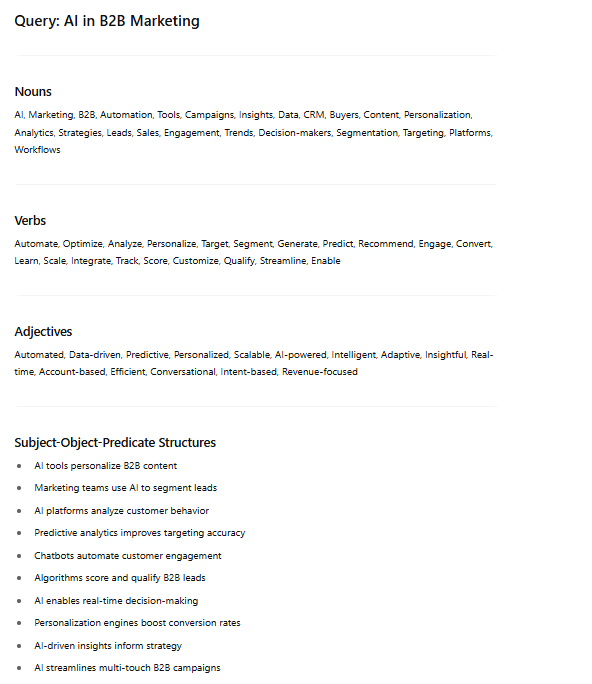
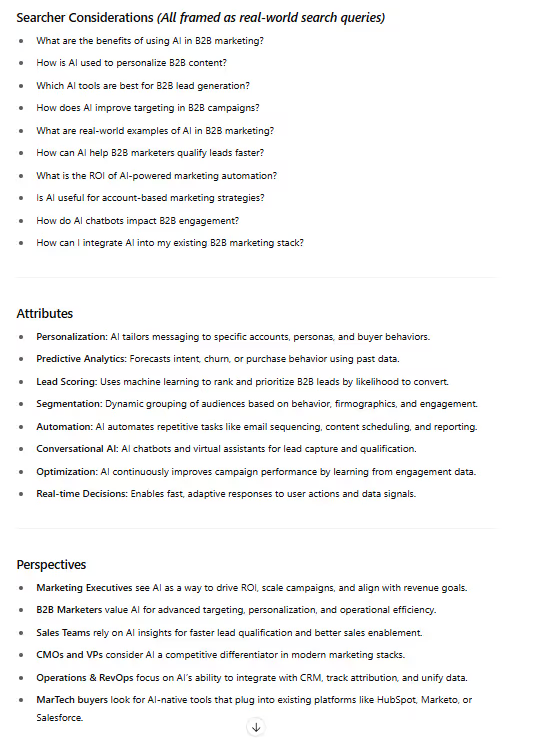
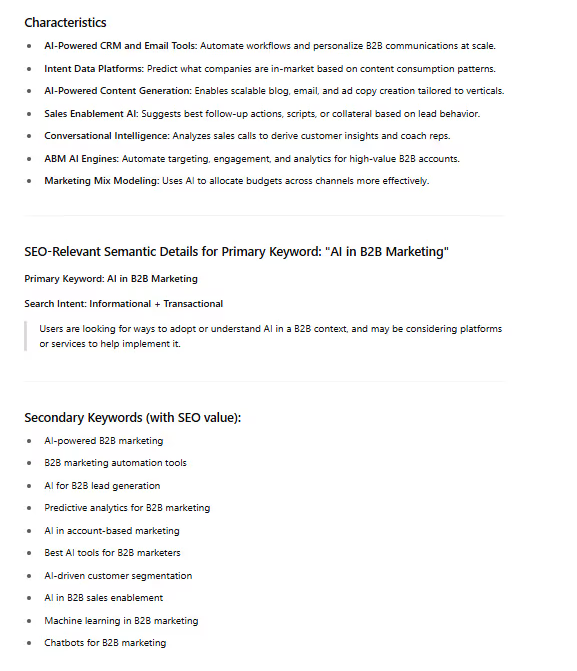
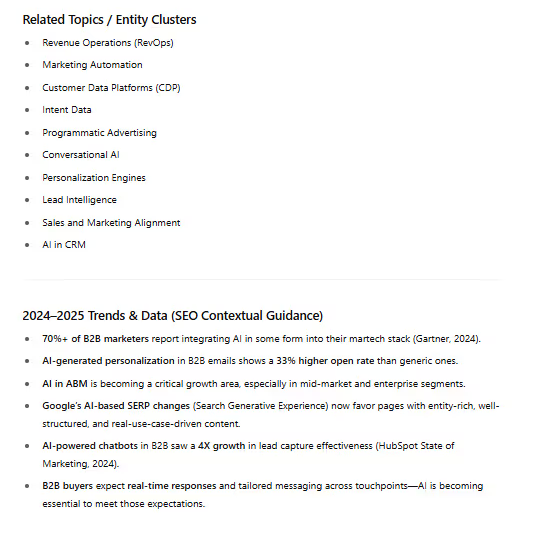
Step 2: Streamlining Research
Research is the backbone of any solid SEO strategy. High-quality research ensures your content is both relevant and valuable to users while aligning with search engine algorithms. Traditional research can be time-consuming, requiring hours of data collection, studying SERPs, and gathering industry insights. This is where AI comes in, streamlining the process and providing faster, more comprehensive results.
At RevvGrowth, research is crucial to our SEO success. Our research-intensive SEO blogs drive rankings for us and our clients. What’s surprising is that we accomplish this level of high-quality research in just 30 minutes, thanks to AI. We use GPT for three types of research:
- SEO Research: We begin with semantic analysis to ensure our keywords are aligned with user intent, as described in the previous section. By using custom prompts, we analyze the full context of a topic to ensure our content is highly relevant.
- Topical Research: For gathering relevant studies, reports, and emerging trends, we use a custom ChatGPT prompt. It pulls in data from reputable sources, including industry studies and research papers, which are integrated into our blogs.
For example, in the "Generative AI in Marketing" blog, we referenced a range of up-to-date, authoritative reports, offering readers a well-researched and comprehensive view of the topic. And we gathered all these resources with the help of our custom GPT prompt within just 30 minutes.
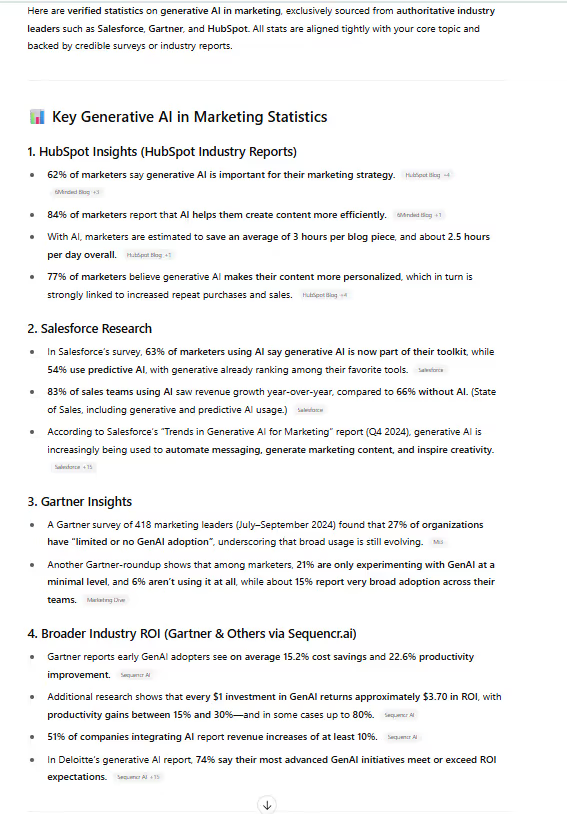
- SERP Research: To understand the competitive landscape, we ask GPT to analyze the outlines of top-ranking blogs. It helps us identify gaps in existing content and ranking opportunities. AI scans for missing sections or untapped keywords, providing us with a strategy to outperform competitors.
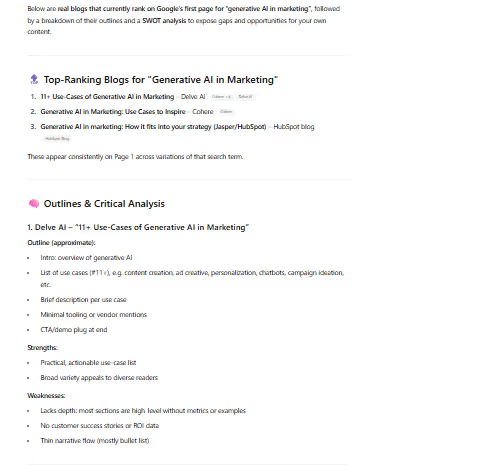
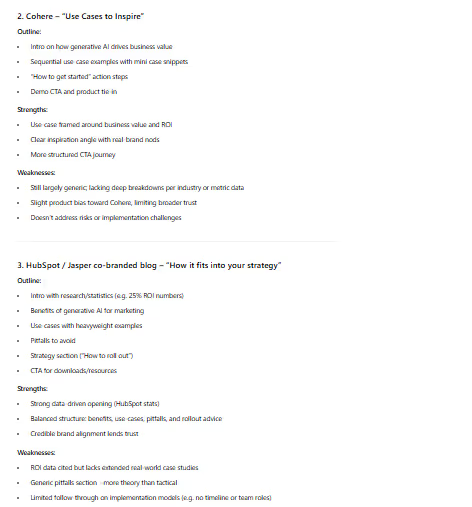
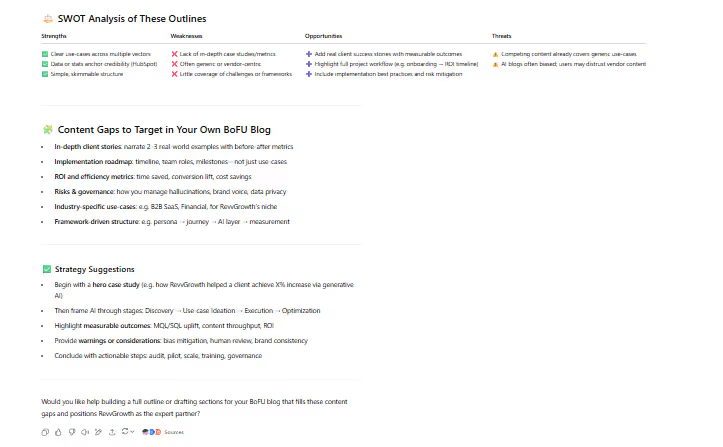
Let’s say you’re writing about “Generative AI in Marketing.” Traditionally, you’d spend time sifting through research papers, articles, case studies, and SERP results to gather relevant data.
But with AI, you simply prompt it for research. AI instantly analyzes the latest reports, identifies key trends in generative AI, and provides a list of relevant studies, statistics, and emerging topics like “AI-driven customer segmentation”, “personalized marketing with AI”, and “AI for content creation in marketing.”
By integrating AI into our research process, we ensure our SEO content is timely, well-researched, and effective, all while drastically cutting down the time spent on manual research.
Step 3: Content Creation
Most people view AI as a tool to automate the entire SEO blog writing process and generate content in one go, hit “publish,” and hope for the best. But that’s not how it works. While AI can speed up content creation, the key to effective use lies in breaking the process down into manageable, focused sections.
At RevvGrowth, we take a step-by-step approach to SEO Content creation. Instead of generating a blog all at once, we use custom prompts for each part of the content, be it the introduction, meta titles, FAQ sections, conclusion, or the main body. Each section is crafted individually, ensuring it’s aligned with SEO goals, user intent, and search engine criteria.
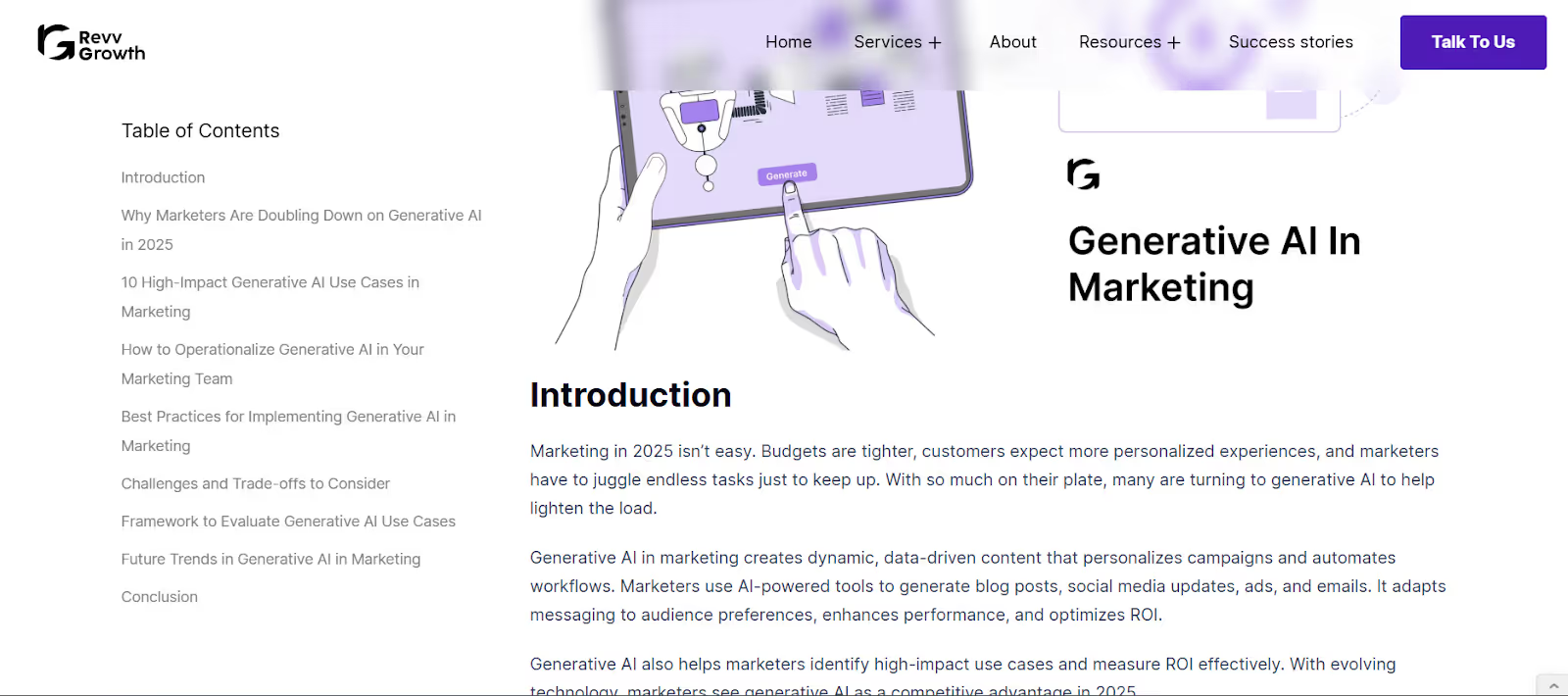
Once all sections are complete, we use another custom prompt to insert research reports, studies, and real-time data into the content at relevant places. This ensures that the content not only flows well but is also backed by credible and up-to-date information, adding value and improving its SEO performance.
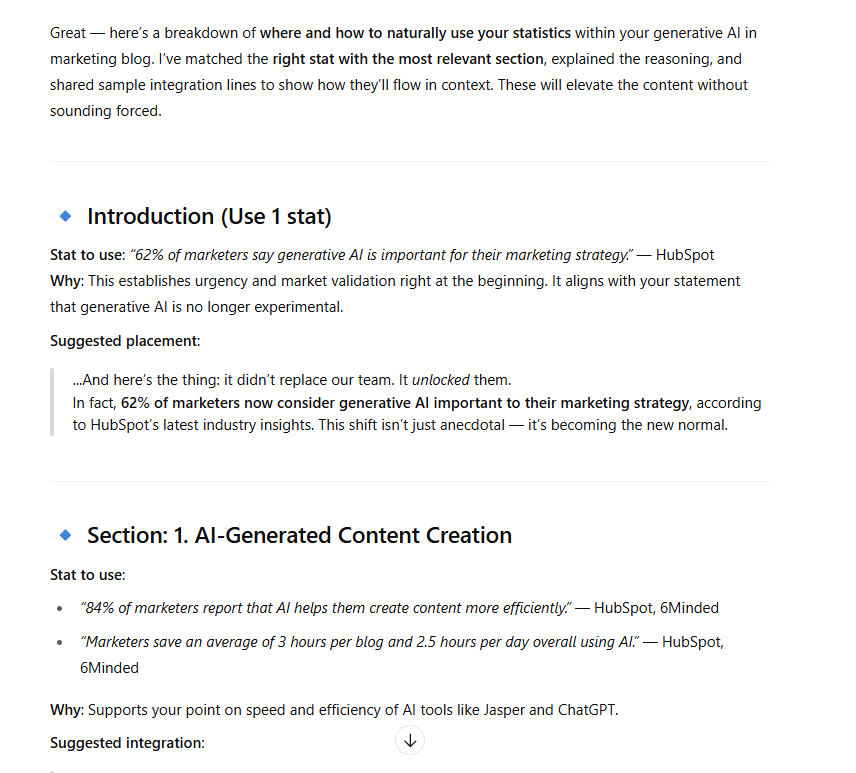
This method ensures we maintain quality, coherence, and SEO optimization throughout the blog creation process, whether for us or our clients. By breaking down the content into focused pieces, we maximize the power of AI while maintaining complete control over the final output.
Step 4: Meta Tags, Titles, and Descriptions
Creating meta tags, titles, and descriptions is a crucial but often tedious task in SEO. These elements are key to improving click-through rates (CTR) and ensuring your content is properly indexed by search engines.
At RevvGrowth, we use GPT to generate SEO-friendly meta tags, titles, and descriptions in one go. With a custom GPT prompt, we generate multiple variations of these meta elements, each tailored to optimize CTR and align with search intent. It helps us ensure that our meta elements remain consistent, relevant, and SEO-optimized for each of our blogs.
For example, for the blogs we create for one of our customers, we use our custom prompt to generate meta titles, descriptions, H1 tags, and more. This prompt consists of specific character limits and other SEO best practices while ensuring all elements are SEO-optimized.
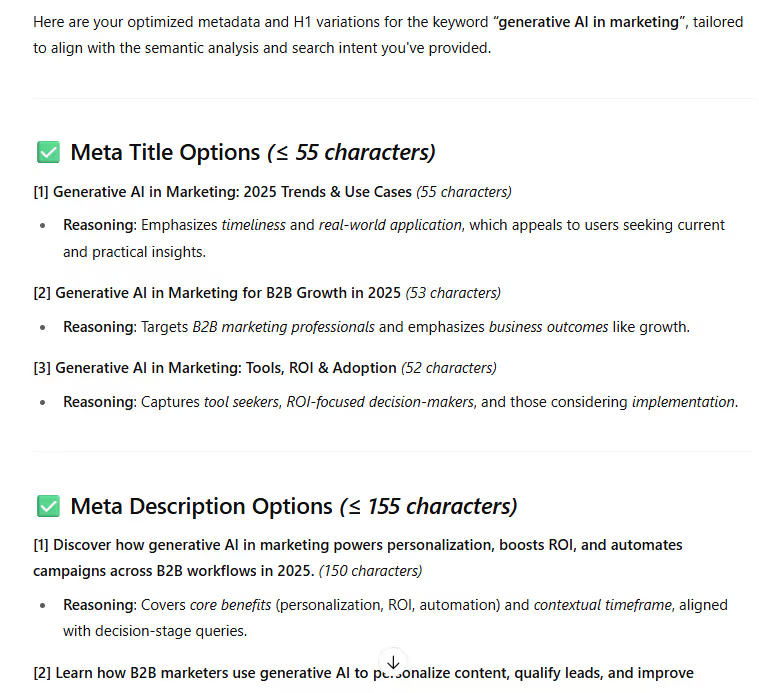
We follow this precise process for all our customers, ensuring that each piece is not only search engine-friendly but also compelling for users. As a result, most of our customers are ranking higher with well-optimized meta elements that improve visibility and drive more organic traffic.
Risks & Limitations of AI Content in SEO
While AI offers speed and scale, it also introduces a host of risks that can undermine content quality and rankings if not carefully managed. Understanding these risks is crucial to leveraging AI effectively in your SEO strategy.
Risks
- Quality Control: AI-generated content can lack the creativity and nuance that human writers bring, often resulting in generic or shallow content.
- Over-Reliance on AI: Excessive dependence on AI can lead to repetitive content, missing out on fresh perspectives or unique insights.
- SEO Penalties: Low-quality AI content or thin content risks being penalized by search engines, which prioritize valuable, well-researched, and original content.
- Contextual Relevance: AI may struggle to maintain consistent context across longer pieces of content, which can affect its relevance to user intent.
- Complexity Handling: AI can fall short when dealing with intricate, multi-layered topics that require deeper understanding or more nuanced writing.
Limitations
- Lack of Emotional Intelligence: AI cannot connect with readers on an emotional level, missing the subtle storytelling and tone human writers bring.
- Inability to Interpret Nuances: AI often misses finer details that might be important for complex topics, resulting in less insightful content.
- Dependence on Training Data: AI content is based on existing data, meaning it can only create what it's trained on, often leading to recycled ideas or repetitive phrasing.
- Customization Constraints: AI tools might not fully capture the brand voice or nuances of a particular industry, making customization essential but sometimes limited.
- Requires Human Oversight: While AI can generate content quickly, it still needs human refinement to ensure it aligns with SEO goals and brand messaging effectively.
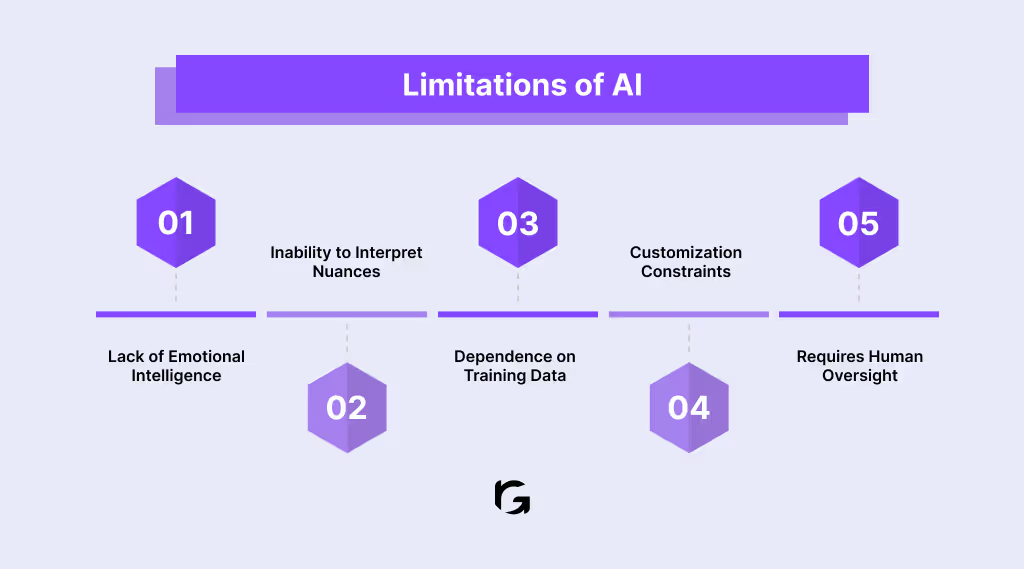
Mitigation Strategies
AI content can be a powerful asset but only when paired with strategy and oversight. To make the most of AI while minimizing risks, you need to combine automation with human judgment. Here’s how to do it effectively.
1. Maintain Quality Control
AI can generate content fast, but it often misses the creativity and nuance human writers bring. Always include human editors in the loop to refine tone, context, and clarity. At RevvGrowth, every AI-assisted draft goes through manual review to ensure accuracy and alignment with brand goals.
At RevvGrowth, quality is embedded into every stage of our workflow. We have a team of experienced content writers and editors who conduct rigorous multi-stage quality checks from reviewing outlines for topic depth, to evaluating AI drafts for clarity and intent, to revalidating accuracy before publishing. This way, we ensure every blog we produce reflects not just SEO best practices, but also strategic storytelling and subject-matter precision.
2. Avoid Over-Reliance on AI
Think of AI as your co-pilot, not your autopilot. Use it for ideation, structure, and optimization but let human insight guide storytelling, analysis, and final decision-making. This balance keeps your content authentic and strategically sound.
At RevvGrowth, we use advanced prompt workflows for tasks like outline generation and semantic structuring but the research and reasoning behind each piece remain human-led. Our writers manually analyze SERPs, fact-check data points, cross-verify references, and refine tone, ensuring that every blog aligns with both search intent and audience expectations. AI gives us speed, while our team ensures depth and direction.
3. Protect Against SEO Penalties
Search engines prioritize original, high-quality content. Always run AI-generated text through plagiarism and quality tools like Surfer SEO, Clearscope, or Originality.ai. Refine your drafts to improve depth and ensure they meet Google’s E-E-A-T standards (Experience, Expertise, Authoritativeness, Trustworthiness).
At RevvGrowth, we maintain a strict no-policy toward low-value, mass-produced content. We don’t believe in churning out AI text for volume. Instead, we rely on a hybrid AI + human intelligence approach, where every piece is carefully optimized for quality, originality, and insight. This balance helps our clients build long-term authority without risking SEO penalties or trust dilution.
4. Strengthen Contextual Relevance
AI sometimes loses context in long-form writing. You can counter this by using strong semantic prompts that clearly define the topic, intent, and structure before generation. The more context AI has, the more coherent and relevant your output will be.
At RevvGrowth, contextual accuracy is one of our biggest strengths. We take time to train our writing teams and AI systems on each client’s industry, product, audience, and messaging pillars. This ensures every piece of content, whether generated or optimized, mirrors the client’s unique value proposition and brand voice. Our AI systems are also trained with context-specific prompts to maintain semantic consistency across long-form SEO assets.
7. Keep AI Outputs Current
Since AI models are trained on historical data, ensure your content includes fresh stats, case studies, and sources. Use custom prompts or manual research to inject recent information before publishing.
At RevvGrowth, we’ve built custom research prompts that help our strategists identify the most recent studies, data, and trends in under 30 minutes. But we don’t stop there, our editors manually cross-verify every statistic and citation using trusted industry sources before publishing. This dual-layer approach ensures our content remains current, credible, and data-driven, not just optimized for keywords.
8. Customize for Brand Voice
AI tools may not fully capture your tone or style by default. Create brand voice guidelines or prompt templates that instruct AI on tone, vocabulary, and target audience. This helps maintain consistency across all content.
At RevvGrowth, we customize every AI workflow to the unique brand voice of our clients. We train AI systems on their content archives, communication tone, and target personas. Whether the brand voice is formal and data-led or conversational and story-driven, we make sure each piece of content sounds unmistakably theirs.
By acknowledging the risks and limitations, and ensuring careful oversight, brands can harness AI's power without sacrificing quality. The key lies in balancing automation with the human touch that search engines and users alike still demand.
Conclusion
The real SEO disruptor isn’t AI. It’s complacency.
In this AI-first era, the brands falling behind aren’t the ones using AI. They’re the ones using it passively, expecting automation to replace strategy. But AI isn’t here to replace thinking. It’s here to accelerate execution. If you’re not adapting how you research, structure, and optimize, you're not keeping up. You’re playing catch-up.
The edge now belongs to those who combine AI’s speed with human clarity, context, and judgment. SEO is no longer about volume. It’s about velocity, precision, and alignment with real user intent.
AI didn’t replace SEO. It redefined it.
The next era belongs to brands who master GEO, AEO, and adaptive content strategy.
RevvGrowth is already there; let’s get you there too
At RevvGrowth, we help B2B companies use AI to boost their SEO and content. Want to see how we implement this for B2B clients? Book a Strategy Call Let’s talk about how we can help your brand grow with AI-powered strategies.
FAQs
1. Does AI-generated content hurt SEO rankings?
No. AI content does not inherently harm SEO. When used strategically, AI can improve content quality, optimize for user intent, and enhance search visibility. Research shows businesses integrating AI into content processes often see increased traffic, higher rankings, and improved engagement.
2. What is the difference between GEO and AEO in SEO?
GEO (Generative Engine Optimization) focuses on optimizing content for AI-powered search engines to appear in AI-generated answers. AEO (Answer Engine Optimization) targets structuring content to directly answer user queries in featured snippets, voice search, and AI overviews. Both prioritize user intent, clarity, and relevance over traditional keyword stuffing.
3. How can AI improve content research for SEO?
AI streamlines research by quickly analyzing semantic SEO, topical trends, and SERP competition. It can identify relevant keywords, authoritative sources, and content gaps, allowing marketers to create comprehensive, data-backed blogs faster than manual research.
4. What are the risks of using AI content for SEO?
AI content risks include low-quality or generic writing, repetition, lack of emotional nuance, and potential SEO penalties if content is thin or irrelevant. Human oversight is essential to ensure AI content aligns with brand voice, user intent, and search engine guidelines.
5. How should brands leverage AI in their SEO strategy?
Brands should use AI to enhance; not replace their SEO efforts. Key strategies include semantic optimization, step-by-step content creation, integrating research, crafting SEO-friendly meta tags, and balancing automation with human review. This approach ensures higher engagement, better rankings, and user-centric content.

.avif)

.svg)
.avif)

.avif)

.avif)
.webp)